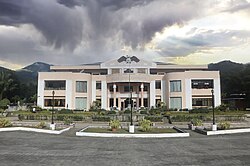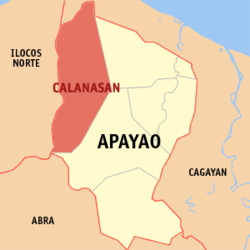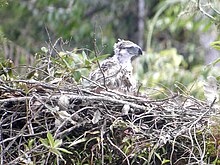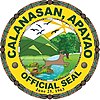Calanasan
This article needs additional citations for verification. (July 2024) |
Calanasan
Bayag | |
|---|---|
| Municipality of Calanasan | |
 Municipal Hall (Balay daya Ymandaya Bldg.) | |
 Map of Apayao with Calanasan highlighted | |
Location in the Philippines | |
| Coordinates: 18°15′18″N 121°02′37″E / 18.255°N 121.0436°E | |
| Country | Philippines |
| Region | Cordillera Administrative Region |
| Province | Apayao |
| District | Lone district |
| Founded | June 25, 1963 |
| Barangays | 18 (see Barangays) |
| Government | |
| • Type | Sangguniang Bayan |
| • Mayor | Shamir M. Bulut (NP) |
| • Vice Mayor | Martin Lucero B. Lawat (NPC) |
| • Representative | Eleanor Bulut-Begtang |
| • Municipal Council | Members |
| • Electorate | 8,552 voters (2022) |
| Area | |
• Total | 1,256.15 km2 (485.00 sq mi) |
| Elevation | 554 m (1,818 ft) |
| Highest elevation | 1,220 m (4,000 ft) |
| Lowest elevation | 258 m (846 ft) |
| Population (2020 census)[3] | |
• Total | 12,550 |
| • Density | 10.0/km2 (26/sq mi) |
| • Households | 2,607 |
| Economy | |
| • Income class | 1st municipal income class |
| • Poverty incidence | 27.38 |
| • Revenue | ₱ 297.4 million (2020) |
| • Assets | ₱ 700.7 million (2020) |
| • Expenditure | ₱ 204.8 million (2020) |
| • Liabilities | ₱ 88.92 million (2020) |
| Service provider | |
| • Electricity | Kalinga - Apayao Electric Cooperative (KAELCO) |
| Time zone | UTC+8 (PST) |
| ZIP code | 3814 |
| PSGC | |
| IDD : area code | +63 (0)74 |
| Native languages | Isnag Ilocano Tagalog |
Calanasan, officially the Municipality of Calanasan, (Isnag: Ili naya Calanasan; Ilocano: Ili ti Calanasan; Tagalog: Bayan ng Calanasan), (formerly known as Bayag,[5] meaning "slow") is a 1st class municipality in the province of Apayao, Philippines. According to the 2020 census, it has a population of 12,550 people, making it the least populated municipality in the province.[3]
Its land area is 1,256.15 square kilometres (485.00 sq mi), making it the largest municipality in the province. Calanasan is the source of the Apayao River which empties into the South China Sea and is the only navigable river in Apayao.
Geography
[edit]According to the Philippine Statistics Authority, the municipality has a land area of 1,256.15 square kilometres (485.00 sq mi) [6] constituting 28.46% of the 4,413.35-square-kilometre- (1,704.00 sq mi) total area of Apayao.
Calanasan is 607 kilometres (377 mi) north from Manila and located in the north-western section of Apayao bordering Santa Praxedes and Claveria in the north, Adams, Vintar, and Carasi in the west, Solsona and Nueva Era in the south-west, Kabugao on the south, and Luna and some parts of Kabugao on the east.
The town's topography or slope is predominantly rugged and mountainous with sporadic flood plains and plateaus. The municipality cradles the larger part of the Apayao-Abulog watershed area as the main source of streams that fills the mighty river which originates from the municipality.[citation needed]
Calanasan has two pronounced seasons, the dry and the wet seasons. The dry season starts in the latest part of December and ends in the middle part of June. The wet season starts in July and ends in the middle part of December. The hottest month is May and rainfall is heaviest in August while strong typhoons usually occur within the period of August to October and the December used to be the coolest month.[citation needed]
Barangays
[edit]Calanasan is politically subdivided into 18 regular barangays and 2 Administrative barangays namely; Barangay Parina and Bucarot under its mother barangay Tanglagan.[7] Each barangay consists of puroks and some have sitios.
| PSGC | Barangay | Population | ±% p.a. | |||
|---|---|---|---|---|---|---|
| 2020[3] | 2010[8] | |||||
| 148101001 | Butao | 6.3% | 792 | 672 | 1.66% | |
| 148101002 | Cadaclan | 7.5% | 940 | 437 | 7.96% | |
| 148101013 | Don Roque Ablan Sr. | 1.8% | 223 | 273 | −2.00% | |
| 148101014 | Eleazar | 1.2% | 145 | 121 | 1.83% | |
| 148101015 | Eva Puzon | 8.5% | 1,063 | 1,072 | −0.08% | |
| 148101016 | Kabugawan | 3.6% | 450 | 484 | −0.73% | |
| 148101003 | Langnao | 1.8% | 230 | 164 | 3.44% | |
| 148101004 | Lubong | 4.1% | 510 | 612 | −1.81% | |
| 148101017 | Macalino | 3.0% | 371 | 265 | 3.42% | |
| 148101005 | Naguilian | 3.0% | 381 | 389 | −0.21% | |
| 148101006 | Namaltugan | 7.5% | 941 | 924 | 0.18% | |
| 148101007 | Poblacion | 16.5% | 2,073 | 1,939 | 0.67% | |
| 148101008 | Sabangan | 3.4% | 432 | 379 | 1.32% | |
| 148101018 | Santa Elena | 2.0% | 253 | 221 | 1.36% | |
| 148101009 | Santa Filomena | 7.1% | 896 | 859 | 0.42% | |
| 148101011 | Tanglagan | 15.9% | 1,991 | 1,951 | 0.20% | |
| 148101012 | Tubang | 3.7% | 468 | 411 | 1.31% | |
| 148101010 | Tubongan | 3.1% | 391 | 395 | −0.10% | |
| Total | 12,550 | 12,550 | 0.00% | |||
Climate
[edit]| Climate data for Calanasan, Apayao | |||||||||||||
|---|---|---|---|---|---|---|---|---|---|---|---|---|---|
| Month | Jan | Feb | Mar | Apr | May | Jun | Jul | Aug | Sep | Oct | Nov | Dec | Year |
| Mean daily maximum °C (°F) | 24 (75) |
26 (79) |
28 (82) |
30 (86) |
29 (84) |
29 (84) |
28 (82) |
28 (82) |
28 (82) |
27 (81) |
26 (79) |
24 (75) |
27 (81) |
| Mean daily minimum °C (°F) | 18 (64) |
18 (64) |
19 (66) |
21 (70) |
23 (73) |
23 (73) |
23 (73) |
23 (73) |
22 (72) |
21 (70) |
20 (68) |
19 (66) |
21 (69) |
| Average precipitation mm (inches) | 55 (2.2) |
41 (1.6) |
37 (1.5) |
41 (1.6) |
184 (7.2) |
215 (8.5) |
261 (10.3) |
256 (10.1) |
245 (9.6) |
216 (8.5) |
142 (5.6) |
129 (5.1) |
1,822 (71.8) |
| Average rainy days | 14.1 | 11.1 | 11.8 | 12.5 | 21.8 | 25.2 | 25.5 | 24.9 | 23.8 | 18.2 | 16.4 | 17.0 | 222.3 |
| Source: Meteoblue (Use with caution: this is modeled/calculated data, not measured locally.)[9] | |||||||||||||
Demographics
[edit]| Year | Pop. | ±% p.a. |
|---|---|---|
| 1918 | 2,509 | — |
| 1939 | 2,743 | +0.43% |
| 1948 | 3,550 | +2.91% |
| 1960 | 3,740 | +0.44% |
| 1970 | 5,214 | +3.37% |
| 1975 | 5,727 | +1.90% |
| 1980 | 5,556 | −0.60% |
| 1990 | 10,699 | +6.77% |
| 1995 | 11,679 | +1.66% |
| 2000 | 12,806 | +1.99% |
| 2007 | 9,663 | −3.81% |
| 2010 | 11,568 | +6.77% |
| 2015 | 12,604 | +1.65% |
| 2020 | 12,550 | −0.08% |
| Source: Philippine Statistics Authority[10][8][11][12] | ||
In the 2020 census, Calanasan had a population of 12,550.[3] The population density was 10.0 inhabitants per square kilometre (26/sq mi).
Calanasan is dominated by the Isnag people, living with them are the Ilocanos and Kalingas. The main languages spoken are the Isnag and the Ilocano.[citation needed]
Economy
[edit]This section needs additional citations for verification. (August 2024) |
Poverty incidence of Calanasan
10
20
30
40
50
60
70
2006
34.60 2009
32.86 2012
62.58 2015
27.08 2018
29.81 2021
27.38 Source: Philippine Statistics Authority[13][14][15][16][17][18][19][20] |
Economic activity in the municipality is based on agricultural production like farming and fishing and livelihood activities like basketry, soft broom making and furniture making.
The municipality has no level lands for extensive rice production except in the northern part of the municipality. The total land area devoted to agriculture is 45.316 hectares (111.98 acres) in which total land area irrigated is 2,347.49 hectares (5,800.8 acres). Its produce include coffee, corn, root crops, peanuts and other legumes, banana, pineapple and some vegetables.
Government
[edit]Local government
[edit]Calanasan, belonging to the lone congressional district of the province of Apayao, is governed by a mayor designated as its local chief executive and by a municipal council as its legislative body in accordance with the Local Government Code. The mayor, vice mayor, and the councilors are elected directly by the people through an election which is being held every three years.
There are also two ex officio councilors – the municipal chapter presidents of the Liga ng mga Barangay and the Pederasyon ng Sangguniang Kabataan. In Calanasan they have reserved seat for the IP Representative as their sectoral representative which is pursuant to the Republic Act 8371, or the Indigenous Peoples (IP) Rights Act of 1997, that calls for the mandatory representation of IPs and it is formally certified by the concerned NCIP regional director, upon recommendation of the provincial or community service center head and shall serve for a period of three years from the date of assumption to office and can be re-endorsed for another term. Members may not serve for more than three consecutive terms.
Elected officials
[edit]| Position | Name |
|---|---|
| Congresswoman | Eleanor C. Bulut-Begtang |
| Governor | Elias C. Bulut Jr. |
| Mayor | Shamir M. Bulut |
| Vice-Mayor | Martin Lucero B. Lawat |
| Councilors | Edgar B. Bulsao |
| Naville K-K Taccalan | |
| Harold Cliff L. Danggan | |
| Denish C. Agubo | |
| Rodante B. Labueng | |
| Irene U. Iddaro | |
| Gerry M. Andres | |
| Scott L. Sucbot | |
| Ex-Officio Member/
ABC President |
Jordy M. Allag |
| Ex-Officio Member/
SK Federation President |
Jess Lee B. Danggan |
| Sectoral Representative/
IPMR |
Denvert K. Andres |
Tourism
[edit]This article has multiple issues. Please help improve it or discuss these issues on the talk page. (Learn how and when to remove these messages)
|
The town has vast variety of wild flora and fauna which contributes to its eco-tourism potential. The town is surrounded with virgin forests, cascading waterfalls, and clear rivers.
Potential tourist attractions include:
- Apayao River — Poblacion
- Girgirra’ Falls — Ninoy Aquino
- Ziwanan River — Cadaclan
- Maxibab Falls — Santa Filomena
- Carmella Falls — Eva
- Pisong Lake
- Danao Lake — Sitio Danao, Poblacion
- Purit Cave
- Bantay Malingudu — Poblacion
- Agamata National Park and Wildlife Sanctuary — near the Ilocos Norte boundary, was established in the remote area of sharp peaks and plateaus. This undeveloped area, with pine stands, lush vegetation and mossy forest, affords a panoramic view of Ilocos Norte and Laoag City on the west. It is ideal for hiking, camping, nature tripping and bird watching.
- Blue Haven — Sta. Elena
- Mount Kilang — Butao
- Mount Sicapoo — Butao
- Botbotan Lake — Tanglagan
Festivals
[edit]Lapat Festival
[edit]- The Lapat Festival celebrates the ancient Isnag practice known as the Lapat system, a revered indigenous method of environmental stewardship. This traditional approach focuses on managing and preserving natural resources and has significantly contributed to increasing the population of the critically endangered Philippine Eagle. The festival highlights the Isnag people's commitment to sustainable development and environmental conservation through the Lapat system, which is cherished as the most beloved practice for protecting and conserving indigenous resources.
- The Lapat Festival was first held as part of Calanasan's commemoration of its founding anniversary and in honor of its conversion as a regular municipality on June 25, 1963, by virtue of Executive Order No. 43. The event includes various activities such as cultural performances, sports competitions, trade and tourism fairs, Calanasan's Got Talent, the Street Dance Competition, and recognition ceremonies, emphasizing both cultural heritage and sustainable tourism. The festival also features the most awaited part, the "Search for Taram se Dam-ag naya Calanasan."
Search for Taram se Dam-ag Naya Calanasan
[edit]- Held during the last day of the town's annual fiesta (usually in the month of June) is the local beauty pageant known as Taram se Dam-ag Naya Calanasan.[a] Representatives from each barangay, grouped into designated clusters, compete for the coveted title of "Taram" (male) "Dam-ag" (female). The winner has the honor of representing Calanasan in the following year's Taer ken Dayag Ti Apayao , held during the provincial founding anniversary every February.
Say-Am Festival
[edit]Say-am: The Isnag's Renowned Celebration and Thanksgiving Say-am is the Isnag people's famous form of celebration and thanksgiving. It is a feast that embodies the traditional way of giving thanks to the Higher Supreme Being, known as "Alawagan," through rituals enriched with vibrant songs, native chants, and dances called "Talip" and "Tad-do." In the past, the celebration of Say-am symbolized status, indicating that a family was respectable and well-to-do. Today, it is celebrated every December 5 in commemoration of the death anniversary of the provincial hero, the late Elias K. Bulut.
Philippine Eagle Sanctuary
[edit]
The Philippine Eagle Foundation began its search of eagles in Apayao in 2011 after reports of huge eagles were roaming the area for centuries.[22] On March 22, 2013, scientists discovered the stronghold of critically endangered Philippine eagles, the country's national bird, in Luzon island within the vicinity of the Calanasan Lowland Forest.[23] In January 2015, the town of Calanasan initiated a program which protected 3,000 hectares of forests under its jurisdiction.[24] Additionally, the province of Apayao is one of the very few in the country which has an approved forest land use plan (FLUP).[25] The first active Philippine eagle nest in Apayao was discovered in July 2015.[22]
On 9 July 2018,[25] the provincial government of Apayao announced their intent for the province to be a UNESCO Biosphere Reserve. The province, which possesses more than 286,000 hectares of virgin forests, also noted that they have sent four of their personnel to train in the United States under the US Foreign Service to hasten the declaration of the site.[26] On January 16, 2019, the provincial government announced that they are at the 'legwork for the inscription'.[27]
See also
[edit]Notes
[edit]- ^ The 'Taram' title was only added in the pageant in the 2024 edition.
References
[edit]- ^ Municipality of Calanasan | (DILG)
- ^ "2015 Census of Population, Report No. 3 – Population, Land Area, and Population Density" (PDF). Philippine Statistics Authority. Quezon City, Philippines. August 2016. ISSN 0117-1453. Archived (PDF) from the original on May 25, 2021. Retrieved July 16, 2021.
- ^ a b c d Census of Population (2020). "Cordillera Administrative Region (CAR)". Total Population by Province, City, Municipality and Barangay. Philippine Statistics Authority. Retrieved 8 July 2021.
- ^ "PSA Releases the 2021 City and Municipal Level Poverty Estimates". Philippine Statistics Authority. 2 April 2024. Retrieved 28 April 2024.
- ^ "Republic Act No. 4980 - An Act Changing the Name of the Municipality of Bayag, Mountain Province, to Calanasan". Chan Robles Virtual Law Library. 17 June 1967. Archived from the original on 4 March 2016. Retrieved 4 November 2016.
- ^ "Province: Apayao". PSGC Interactive. Quezon City, Philippines: Philippine Statistics Authority. Retrieved 12 November 2016.
- ^ "Municipal: Calanasan". PSGC Interactive. Quezon City, Philippines: Philippine Statistics Authority. Retrieved 8 January 2016.
- ^ a b Census of Population and Housing (2010). "Cordillera Administrative Region (CAR)" (PDF). Total Population by Province, City, Municipality and Barangay. National Statistics Office. Retrieved 29 June 2016.
- ^ "Calanasan: Average Temperatures and Rainfall". Meteoblue. Retrieved 8 March 2020.
- ^ Census of Population (2015). "Cordillera Administrative Region (CAR)". Total Population by Province, City, Municipality and Barangay. Philippine Statistics Authority. Retrieved 20 June 2016.
- ^ Censuses of Population (1903–2007). "Cordillera Administrative Region (CAR)". Table 1. Population Enumerated in Various Censuses by Province/Highly Urbanized City: 1903 to 2007. National Statistics Office.
- ^ "Province of Apayao". Municipality Population Data. Local Water Utilities Administration Research Division. Retrieved 17 December 2016.
- ^ "Poverty incidence (PI):". Philippine Statistics Authority. Retrieved December 28, 2020.
- ^ "Estimation of Local Poverty in the Philippines" (PDF). Philippine Statistics Authority. 29 November 2005.
- ^ "2003 City and Municipal Level Poverty Estimates" (PDF). Philippine Statistics Authority. 23 March 2009.
- ^ "City and Municipal Level Poverty Estimates; 2006 and 2009" (PDF). Philippine Statistics Authority. 3 August 2012.
- ^ "2012 Municipal and City Level Poverty Estimates" (PDF). Philippine Statistics Authority. 31 May 2016.
- ^ "Municipal and City Level Small Area Poverty Estimates; 2009, 2012 and 2015". Philippine Statistics Authority. 10 July 2019.
- ^ "PSA Releases the 2018 Municipal and City Level Poverty Estimates". Philippine Statistics Authority. 15 December 2021. Retrieved 22 January 2022.
- ^ "PSA Releases the 2021 City and Municipal Level Poverty Estimates". Philippine Statistics Authority. 2 April 2024. Retrieved 28 April 2024.
- ^ "2022 National and Local Elections". GMA 7. Retrieved September 13, 2023.
- ^ a b "First active Philippine eagle nest in Luzon found in Apayao". 14 July 2015.
- ^ "Eagle Sightings in Apayao - Philippine Eagle Foundation - the official website of the Philippine Eagle Foundation". Archived from the original on 2019-02-09. Retrieved 2019-02-07.
- ^ "bayanihan.org". ww38.bayanihan.org. Retrieved 25 April 2024.
- ^ a b "Apayao eagle habitat eyed as Unesco protected area". The Philippine STAR.
- ^ "Gov Bulut wants Calanasan Philippine Eagle sanctuary declared as protected area | Politiko North Luzon". 27 July 2018.
- ^ "Apayao eyes UNESCO biosphere reserve title to save PH eagles". Philippine News Agency.
External links
[edit]![]() Media related to Calanasan at Wikimedia Commons
Media related to Calanasan at Wikimedia Commons




